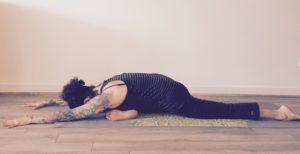Fight or Flight
Resistance vs Avoidance
Which is your tendency? As humans we automatically contract away from that which is uncomfortable and as such, we have a natural tendency to approach a difficulty or an obstacle in our life in one of two ways: We try to avoid it altogether and hope the problem just goes away, or we push back against it (also known as resistance) hoping to remove it from our path, by force if necessary.
The problem is, as many of us have realized, that avoidance rarely makes the problem go away and actively fighting tends to just bring forth a lot of tension and even more discomfort than when we began. Either way, we defeat the main goal, which is to effectively deal with the difficulty so that we can resolve it and move on without hurting ourselves in the process.
In using yoga as a metaphor, (secret: everything you practice on your mat is basically a metaphor for how you walk through the rest of your life) let’s think about our hips.
Many people I know have self-proclaimed “tight hips.” When we are asked to go into a pose that specifically targets the hips, there is a strong tendency, almost a reflex, to fall into your habit of avoiding or pushing.

If you are an Avoider, the discomfort of a pose like pigeon makes it incredibly easy to overload on props, find a half-hearted shape, and then zone out by thinking about what you’re going to eat for dinner or that conversation you had with your mum earlier today. I mean, the pose is uncomfortable. I really hate it. And my dumb hips are never going to open up anyway, so why bother? Are we done yet?! Avoiders know this inner dialogue well.
Alternatively, if you are a Pusher, your big strong ego does not like the fact that this is as far as you can go in this pose and dang it! You can do better! You know you can. You Must. Go. Deeper. Pushers approach most problems with the attitude that they’re just not trying hard enough and that with more effort, better results will follow. Well, needless to say, for anyone who’s pulled or over-stretched one of the many muscles, ligaments or tendons surrounding the hip area (present company included) that approach certainly does nothing for helping you reach your ultimate goal of opening your hips. In fact, pushing yourself too far will more than likely end up side-lining you from your mat altogether, or worse, make it difficult to even walk down the street.
Does any of this sound familiar? For most of us, if we are honest with ourselves, we can find shades of one (or both) of these qualities in the way we not only practice yoga but move through our life. The thing is, both qualities can be a huge asset if applied appropriately to their unique scenario. The key, however, is first identifying your go-to habits and then more importantly, understanding your motivations behind them.
That last bit can be very profound… because it’s not always so clear as to what, exactly, our motivations are. For instance, most of the time I am a Pusher. I push myself because I want to (over?) achieve and be perceived as being “really good” at whatever I happen to be doing. But there are moments and situations when I become the world’s worst Avoider. And at those moments the task is likely asking me to be vulnerable (ie, “not good enough”) in some way… something that historically I’ve avoided with great skill. Vastly different approaches to seemingly different issues, but in reality: two sides, same coin.
So the first imperative step is understanding what you do, then when you do it, and most importantly why. These questions take a great deal of self-reflection, insight and awareness, but once the patterns come to light, things start to shift dramatically.
Once we begin to recognize our habitual behavior we can begin the arduous task of trying to better accept where we are (envision pigeon pose again) without the need to forcefully alter it or avoid it. This step is where the real work of yoga (and subsequently our life) lies. To simply BE in the discomfort of something you cannot immediately or effectively change and learn to find a place of peace in the middle of it, well that is the real gift.
 It can be incredibly difficult but profoundly rewarding to just accept yourself where you are. If you are an Avoider, you have to sit in the discomfort of the pose by actually engaging with it. Breathe with it, feel it, be really present with what you’re experiencing every step of the way. Eventually you begin to notice that discomfort is relative and most likely not nearly as bad as all the amping up you’ve given it, and with enough patience and engagement, you will likely notice your hips have actually opened up a bit too.
It can be incredibly difficult but profoundly rewarding to just accept yourself where you are. If you are an Avoider, you have to sit in the discomfort of the pose by actually engaging with it. Breathe with it, feel it, be really present with what you’re experiencing every step of the way. Eventually you begin to notice that discomfort is relative and most likely not nearly as bad as all the amping up you’ve given it, and with enough patience and engagement, you will likely notice your hips have actually opened up a bit too.
Alternately, Pushers have to step back and just let the hips be tight. Let them open up at their own pace, not the pace your mind is telling you to go. But again, engagement with what you’re feeling is imperative. Being aware of your dissatisfaction and desire for something different, and sitting calmly with the fact that things are not as you’d like them to be, is the key. Breathe with the feelings, try to look with a sense of curiosity instead of judgement and see if your perspective shifts, even just a little bit. Yes, it can be very uncomfortable (physically and emotionally) but it’s also ok. It really is.
All of this is not to say that there aren’t times when as a Pusher it’s MORE appropriate to apply extra effort, or as an Avoider to back off altogether. And yes, it can be very confusing. So how do we know? This is one of the most brilliant things about a consistent yoga practice. When you are really paying attention to what’s happening in your body and in your mind, you start to develop the profound skill of discernment between the two… and this discernment is critical because we often mistake the messages of the body and the messages of the mind as the same thing despite the fact that they are often at great odds with one another.
Some days my mind feels lazy or resistant and is pulling me out of pigeon pose but my body knows I would benefit by going deeper. And some days my ego wants to push the limits of the pose but my body is softly telling me to back off. The answer is always clear if I am really listening to what the wisdom of my body is saying without the ego-mind trying to sway me otherwise.
So next time you’re struggling to achieve more or you’re feeling like fleeing the situation altogether, try to tune out the story in your head and tune into the message from your body. You might be surprised at what it’s trying to tell you.



